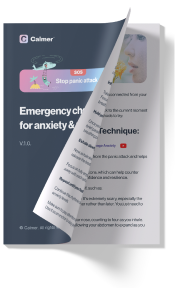Key Takeaways:
- OCD Cycle = obsessive thoughts you can get rid of, followed by strong feelings of anxiety. You then complete a behavior to get temporary relief from the thoughts before they start again, and the cycle repeats.
- There are many strategies to break the cycle, including mindfulness and therapies such as ERP and CBT – all designed to disrupt the pattern and help you take back control of your life.
- You can also use a wide range of apps, tools, and resources alongside these strategies, including the GoCalmer app, support groups, and educational information.
You know those paranoid thoughts you get before you go on vacation? Things like ‘Did I remember to turn off the oven before leaving the house?’ or ‘Did I pack underwear?’. Yeah, everyone gets those. It offers a bit of fear for a few short moments, but often, that fear fades away, and the thought is pushed into the back of their heads.

But if you’re constantly getting these thoughts and fears and always going back to double check and reassure yourself, it could be a sign of obsessive-compulsive disorder (OCD) – and you could be stuck in a dreaded cycle.
Below, we’re going to dive deep into the OCD cycle to help you understand it a bit more while also providing some essential tools and treatments that can help set you free.
What is an OCD cycle?
OCD is made up of a constant cycle of obsessive thoughts and compulsive behaviors, making you feel like you don’t have control over your own life anymore. Just like having asthma or diabetes, it’s chronic, but that doesn’t mean there aren’t ways to break the cycle and start living the life you deserve to live.
We’ve already mentioned those silly thoughts that pop into everyone’s heads. They are different for everyone but short-lived for most. In an OCD cycle, these little silly thoughts become intrusive and will literally not leave your mind – no matter how hard you try. These are OCD obsessions. For example, if you can’t remember locking your front door before leaving the house, you will constantly ruminate on that thought until you get home.
If you’re out and supposed to be having fun with your friends, you will continue having these thoughts until you can go home and check your door. You’ll feel extremely uncomfortable and doubtful, bringing on high levels of anxiety. These feelings and thoughts will not leave until you take action to check your door. This is a compulsion. It might mean you have to leave the social gathering early to go and check it, but it will offer you temporary relief.
Every obsession and compulsion for each person is different – but they all make up a cycle. Even when you complete your compulsion to ease your obsessive thoughts, when you go back out again, you’ll start thinking about whether you locked your door once more.
Going through the stages of OCD
There are four distinct stages of the cycle – no matter what type of OCD you suffer from, what your intrusive thoughts are, or the repetitive behaviors you act upon.
Obsessions
An obsession is an intrusive thought that will not go away, no matter how hard you try. Some know that it’s false, but others are completely convinced it’s true.
Anxiety
Since your obsessive thoughts won’t leave your mind, you start to feel very uncomfortable, bringing strong feelings of anxiety. All you want to do is get rid of this feeling.
Compulsions
A compulsion is a behavior you complete to get rid of your obsession. For example, going to check if the door is locked when you didn’t know if you had locked it before leaving the house.
Temporary relief
Once you complete your compulsion, you’ll feel relief take over your body, easing your anxiety. However, this is only short-lived, and you’ll soon start to experience your obsessions again, restarting the cycle.
Strategies to break the OCD cycle
The OCD cycle can completely take over your life, stopping you from doing the things you used to love and experiencing each day to the fullest. But it doesn’t need to be that way. Many great strategies can help you break the shackles of the cycle and start feeling yourself again.
Exposure and response prevention (ERP)
One of the main treatments for OCD and its cycle is ERP. It is made up of two parts: exposure and response prevention. The exposure part makes you face your obsessions head-on, having to experience the anxious thoughts and feelings. The response prevention part stops you from completing the compulsive behavior that usually gives temporary relief.
It might sound a bit off-putting having to make yourself anxious and deal with uncomfortable thoughts purposely, but several studies have found that ERP is one of the most effective forms of treatment for OCD. You don’t have to do it alone; you’re with a trained therapist the entire time to offer guidance and comfort when needed.
While you might feel an increase in anxiety, obsessive thoughts, and guilty feelings at first, you will start to realize that none of this can hurt you. It isn’t something that will happen straight away, but over time, you’ll learn that they are completely manageable. These feelings will eventually subside when you stop fighting the obsession to complete the compulsion.
Cognitive behavioral therapy (CBT)
ERP isn’t the only therapy out there for OCD, and you can also give CBT a try if you feel more comfortable doing so. It’s a talking therapy, so it doesn’t deal with the intense exposures, however, it is still very different from traditional counseling. It’s much more structured, and each therapist tailors your CBT sessions to your individual obsessive thinking and compulsive behaviors.
You don’t need to dig up the past with CBT for effective treatment. Instead, it focuses on your ‘here and now’ issues. It wasn’t made to go on for years and years, hoping you’ll get better. Instead, it lasts for a short time, helping you break the cycle for good.
A systematic review found that CBT for OCD is an effective treatment when delivered in routine clinical care. It explores how you think, finding alternative ways to do so while also challenging your beliefs through behavioral exercises. You get to understand better and confront your OCD symptoms and are given tools to handle them in the future.
Mindfulness
You know those days when you’re driving home from work, you get into your car and get home, and you don’t remember the drive at all? It’s sort of like you were on autopilot. Well, this is the OPPOSITE of mindfulness. Mindfulness focuses on your thoughts and actions, allowing you to consciously live in the ‘now.’
Practicing mindfulness with OCD can be scary for some. While you usually try to push your intrusive thoughts away, you’re now allowing them in. You get to look at your thoughts more as an observer than the person experiencing them, allowing you to critically analyze them and give your mind time to relax.
Although it might appear challenging, a 2017 study looking at mindfulness as an additional augmentation treatment following CBT found a strong decrease in OCD symptoms in patients compared to a waitlist control group. Not only did it also help reduce other mental health symptoms like depression and anxiety, but patients also reported high levels of satisfaction with the intervention.
Apps and resources
While we recommend using some sort of therapy to break the OCD cycle, we understand that you might want to start off with something smaller or even look for something to use on the side. That’s why we developed the Calmer anxiety relief app, which you can load up straight on your phone or tablet and access a wide range of helpful mental health tools, from guided meditation to instant anxiety relief tools.
If you want to talk to people who might be going through the same process as you of breaking the OCD cycle, there are some great support groups to join. Consider ANXIETY, a peer-led support group for adults struggling with anxiety, OCD, or panic attacks. It’s entirely free and meets via Zoom every Thursday. There might also be some in-person groups in your area.
It’s also a good idea to always stay up-to-date on information about OCD so you can truly understand what’s happening to you. Some great resources are out there, including the OCD Stories Podcast and OCD Challenge educational course.
Conclusion
Obsessive-compulsive disorder comes in all shapes and sizes, from relationship OCD to hoarding disorder. No matter what category you fit into, it can feel debilitating when obsessive thinking and compulsions take over your life. However, it doesn’t have to be this way, and breaking the cycle is very much possible.
We’ve given you some of the best treatments and strategies out there to ease your OCD symptoms and start living the life you want. You might need to put in some work, but it’ll all be worth it in the end. We know you can do it.

